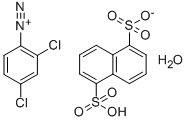
IdentificationPhysical DataSpectraRoute of Synthesis (ROS)Safety and HazardsOther Data
Identification
Product Name32,4-Dichlorobenzenediazonium 1,5-naphthalenedisulfonate hydrate CAS#: 123333-91-5Molecular StructureCAS Registry Number 123333-91-5MDL NumberMFCD08457580SynonymsMolecular FormulaC16H12Cl2N2O7S2Molecular Weight479.312InChIInChI KeyCanonical SMILES
Physical Data
AppearanceFaint Yellow to Yellow to Beige and Faint Brown to Light Brown to Light Orange powder
Spectra
No data available
Route of Synthesis (ROS)
No data available
Safety and Hazards
GHS Hazard StatementsNot Classified
Other Data
TransportationHS CodeStorageStore at 2~8° for long time.Shelf LifeMarket Price
Use Pattern2,4-Dichlorobenzenediazonium 1,5-naphthalenedisulfonate hydrate CAS 123333-91-5 is used a intermediates. 1,5-Naphthalenedisulfonic acid salt hydrate is a coordination compound commonly used as a reagent or intermediate in organic synthesis. It can be employed in the synthesis of pharmaceuticals, dyes, polymers, and other organic compounds. In the laboratory, it can also serve as a catalyst or precursor to catalysts in organic synthesis reactions.
https://www.chemwhat.com/24-dichlorobenzenediazonium-15-naphthalenedisulfonate-hydrate-cas-123333-91-5/
Comments
Post a Comment